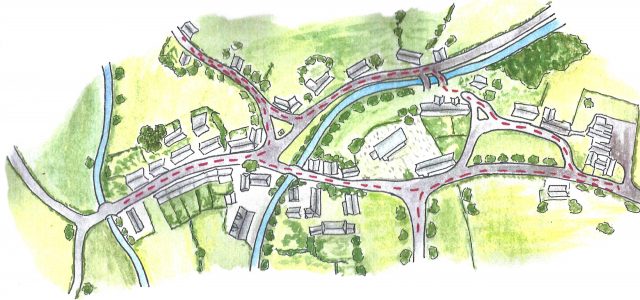
HERITAGE TRAIL
Andrew Stachulski reviews a fascinating heritage trail booklet, produced by Colin Davenport and Joan Levet, that takes visitors around the ancient village of Bolton-by-Bowland. Illustrations: Josie Guthrie and Meg Blackledge
For many visitors, the charming village of Bolton-by-Bowland is likely to be one of their first experiences of the Forest of Bowland. The village is easily accessible, lying barely two miles from the busy A59, and about six miles from Clitheroe, but it will quickly transport you back into a district of rich heritage and history.
Although the old Bolton Hall no longer exists – it was demolished in 1959 – the character of the old estate lingers in many ways, with echoes of the Pudsays, Littledales and Wrights all around you as you stroll through the quiet streets.
Now that the village has been short-listed for Channel 4’s Village of the Year competition, it will deservedly attract still more attention.
There will always be those who like to explore and discover for themselves, and they will find plenty to occupy their detective skills here. But for those who wisely decide to take advantage of distilled local heritage and guidance, there is a splendid handbook available, the Bolton-by-Bowland Heritage Trail, recently written and produced by Colin Darlington and Joan Levet. The trail is set out as a walk starting from the main village car park, and in the space of about a one mile stroll it conducts you through a fascinating sequence of buildings and places which tell the story of the village. The booklet is splendidly illustrated by Josie Guthrie and Meg Blackledge and is a pleasure to browse through. Without wishing to steal the authors’ thunder, some highlights of the village’s history will, I hope, whet the visitor’s appetite.
The village was recorded in the Domesday book (1087), but the largest part of the Heritage Trail is rooted in the estate, dating from about 1350, and the fascinating parish church of St Peter and St Paul. Indeed, the church makes an excellent starting point for any visitor with even a minimum time to spare. Note the commanding tower, said to have been designed by King Henry VI while he was being sheltered at the hall in the 1460s.The Pudsay chapel is dominated by the remarkable tomb of Sir Ralph Pudsay, and in the Pudsay Chapel you can find much more interesting history, including that of the Littledales. They were 19th Century lords of the estate, and the fine old courthouse, used judicially within living memory, dates from this era of the village history. It makes a fine appearance from the Gisburn road, seen across the school green.
Another former lord of the manor, William Pudsay of the 16th century, is also associated with a fascinating history. He was said to have minted his own currency and, in fleeing from his pursuers when the mint became known, to have made a remarkable leap across the Ribble at Rainsber Scar to safety. The myth has been frequently debunked, but it was the subject of a poem by Henry Anthony Littledale, of the manorial family again, in 1859.
Copies of the Heritage Trail are available from Tim Hall’s shop and tea rooms in the main village street, from the Coach and Horses Inn, Holden Clough Nursery and the parish church, and for £3 it represents excellent value. Visitors are strongly recommended to visit Tim’s shop and café for anything from coffee or tea to a full and satisfying lunch. Further down the street, the splendidly refurbished Coach and Horses hotel now once more offers accommodation and a fine dining menu. In short, enjoy your visit to Bolton-by- Bowland and, aided by local knowledge, tradition and hospitality, why not turn your visit into a mini break?
HERITAGE TRAIL WALK
The Bolton-by-Bowland Heritage Trail includes some suggestions for additional walks – an extension is suggested here for those who may enjoy something a little longer.
Opposite the church, pass through the gates of the old park and follow the course of the driveway towards the site of the old hall. The modern, and private, development of King Henry’s Mews appears just beyond the small domed construction which covers the aforementioned well. From here you can take a path climbing rather steeply to your left, soon reaching a little copse with the finely situated buildings of Scott Laithe just behind. This spot commands a lovely view down the Ribble valley towards Sawley.
Behind Scott Laithe, follow another path, eventually turning more to the right and approaching the wood above Rainsber Scar above the steep defile falling to the Ribble. Keep above the wood and soon reach the farm of Fooden, whence you can take a well-defined path leading WNW. This converges with the Gisburn road at Cow House Hill, where you simply cross a stile and turn down left back to the village to complete a most enjoyable short outing.
Andrew Stachulski is co-author, with Helen Shaw, of ‘The Forest of Bowland’, published by Merlin Unwin at £14.99

